Is it possible, and most importantly, is it necessary to use chlorhexidine for acne on the face? How effective is this wiping? This substance is a local antiseptic that eliminates the infection, but does not fight the cause of acne, so it can be used as an adjuvant.
The local antiseptic is effective against many bacteria, viruses and fungi, even those resistant to antibiotics (it itself does not belong to this group of drugs). It is used for external use for various lesions of the skin and mucous membranes. The product has an antibacterial effect, but does not dry the skin and practically does not cause allergic reactions.
The instructions provide for this drug only for external use - wiping the dermis, rinsing the mouth and throat. If ingested, irritation of the gastric mucosa and vomiting may occur. For this reason, it is not recommended for young children to use the product without adult supervision. There have been no cases of poisoning or overdose, either with proper use or with oral administration.
Chlorhexidine is a fairly effective remedy for acne. Since one of the links in the pathogenesis of acne is inflammation of clogged ducts of the sebaceous glands, a local antiseptic will be useful. It eliminates pathogenic microflora from the epidermis, thus helping to reduce the intensity of the inflammatory process, preventing its development and the penetration of bacteria into the affected area.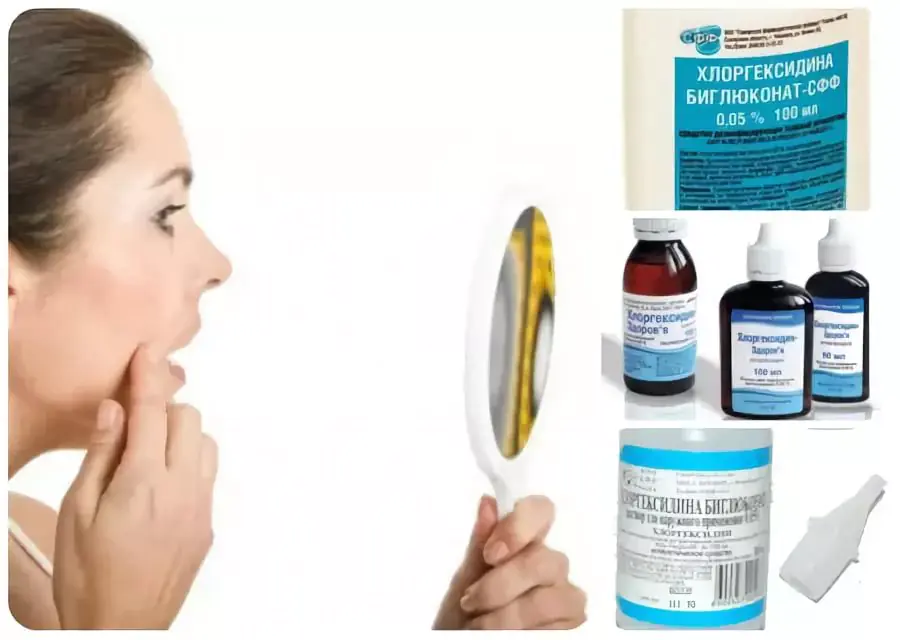
To achieve maximum effect, you need to wipe your face with chlorhexidine for acne 3-4 times a day.
It can also be used to prevent inflammatory diseases of the facial skin in cases where proper care and personal hygiene are difficult. For example, on a long trip, in nature, when it is not possible to use the entire range of care products, and the skin is prone to inflammation.
It is advisable to use the solution as part of a complex treatment. In order to completely eliminate acne, it is necessary to combine proper nutrition and a healthy lifestyle that maintains a normal supply of nutrients to the body, treatment of diseases of the digestive and endocrine systems, if any, proper skin care, sufficient hydration of the epidermis and wiping the face with local antiseptics.
Whether chlorhexidine helps with acne depends largely on how it is used. There are several simple rules on how to use it to get the desired result:
- Before wiping your face, you need to wash your hands and wash your face.
- After using chlorhexidine bigluconate for acne, you do not need to wipe it off, the product will dry on its own.
- After the product has dried, you need to apply a moisturizer.
Chlorhexidine against acne is much more effective if you use special cleansers against acne and blackheads, deep cleansing scrubs, moisturizing and nourishing creams that will help regulate the functioning of the sebaceous glands. A qualified dermatologist will help you choose the right regimen for caring for your epidermis. But if acne is severe, you will need the help of several specialists and a detailed diagnosis of the causes of skin diseases.
Side effects when using the drug are quite rare. In some cases, hypersensitivity to the active substance is observed. The question of whether it is possible to wipe the face with chlorhexidine for acne if local irritation is observed should be decided by a doctor.
Itching and burning of the skin is possible when applying the drug, which disappear on their own within a few seconds without any additional measures. This is caused by a slight irritant effect of the active substance on damaged skin. Most often, such phenomena only cause discomfort, but do not have serious consequences.
Chlorhexidine against acne cannot be used for severe inflammatory diseases of the dermis - its effectiveness will not be enough for treatment; antibiotics are required. Also, you should not resort to this remedy in case of serious injuries to the face and head for the same reason.
If the use of the drug does not have a significant beneficial effect, you should consult a doctor and select a comprehensive treatment regimen. It is even more worth doing this if the condition of the patient’s dermis worsens, foci of inflammation appear, and scars remain after acne.
The drug to combat acne can be purchased at pharmacies, as well as in hygiene departments; a prescription is not required to purchase it. The shelf life is 2 years when the package is closed; an opened bottle is good for about a month. After the expiration date, the drug is no longer suitable for use and its effectiveness is significantly reduced. It is recommended to store at room temperature, away from children and pets.
Anastasia, 16 years old, Omsk
I have problems with my skin, my mother says it’s hormonal and will go away in two years. She advised me to wipe my face with chlorhexidine to reduce breakouts. My acne has really decreased and my face has become clearer. But what really helped was that I started watching my diet, and now I look like a girl.
Evgeniya, 25 years old, Kemerovo
I haven’t thought about acne for a long time. And then suddenly they started to break out a long time ago when they were no longer in their teens. It turned out to be a hormonal imbalance, and I was prescribed a long course of treatment. I take hormonal pills, immunostimulating agents, and vitamins. I'm learning how to properly care for my face. To prevent acne from becoming inflamed, the dermatologist advised wiping it in the mornings and evenings with chlorhexidine. Within a month, a noticeable result is almost completely healthy skin, but it reacts very sensitively when I eat something wrong.
Kirill, 24 years old, Tyumen
I thought long and hard before writing this review. Still, I’m not a girl to talk about such things. But it turned out that my skin is ugly, there are always some kind of rashes, spots, or whatever these things are called. In general, I made an appointment with a dermatologist, he prescribed me a lot of things, including chlorhexidine. It helps, but slowly.
Ekaterina, 34 years old, Omsk
I dealt with acne on my face quite quickly with the help of chlorhexidine and a healthy diet. I had to wipe my face every day, 3-4 times, but as a result, the acne completely disappeared, no new ones appeared, and after a week I already looked much better. Now I haven’t had any problems with my skin for six months, although I don’t use any special products, I just wash my face regularly.
What is more effective - using chlorhexidine for acne on the face, or using some other local antiseptic? If we analyze the antibacterial and anti-inflammatory effect, it turns out that miramistin has approximately the same effectiveness. Both products are interchangeable and can be alternated for greater effectiveness.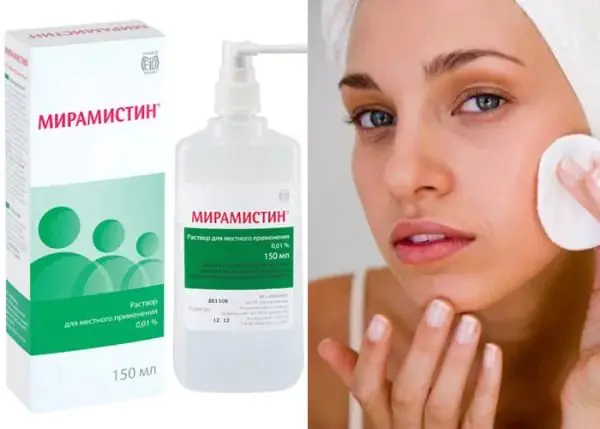
Using hydrogen peroxide and alcohol-based products is less effective. They exhibit the same antibacterial effect, but dry the skin, which provokes increased work of the sebaceous glands, more frequent blockage of their ducts and the appearance of new acne.
A local antiseptic becomes truly effective as part of a complex of facial skin care measures - gentle washing, deep cleansing, moisturizing and nourishing, regulating the functioning of the sebaceous glands, and only then - preventing the growth of microflora. If acne on the face is a consequence of any disease of the endocrine, digestive or immune system, then treatment of the underlying disease is required.
Using chlorhexidine for acne is quite effective in preventing inflammation and preventing infection from spreading to healthy areas of the skin. It is advisable to use this remedy as part of a set of measures for the treatment of acne and as prescribed by a doctor.
Hi all. I'm 19.
I was on vacation at the seaside, my skin was perfect. Not a single pimple, smooth forehead
I returned home and on you, small ones appeared on your forehead again.
There is nothing left to do with them. The T zone suffers.
I’ve been on the right supplement for a long time, I drink a lot of purified water. I take Polysorb for prevention. I don’t put on makeup in the summer, I don’t press it.
I decided to apply chlorhexidine to my forehead and wipe my chin.
Who did he help? Who used it?
Woman.ru experts
Find out the opinion of an expert on your topic
Aleynikova Natalya ValerievnaPsychologist. Specialist from the site b17.ru
Zubkova Anna AndreevnaPsychologist, Gestalt therapist. Specialist from the site b17.ru
Khairullina Rosa RinatovnaPsychologist. Specialist with the site b17.ru
Korotina Svetlana YurievnaPsychotherapist. Specialist from the site b17.ru
Ekaterina Alekseevna VasyukhinaPsychologist, Crisis counseling. Specialist from the site b17.ru
Vera Vladimirovna ZolotykhPsychologist. Specialist from the site b17.ru
Elena BasanovaPsychologist, Family psychologist Skype. Specialist from the site b17.ru
Boyko Inessa BorisovnaPsychologist, Online consultant. Specialist from the site b17.ru
Nevzorova Sofya IgorevnaPsychologist. Specialist from the site b17.ru
Prokopenko Elena AlexandrovnaPsychologist. Specialist from the site b17.ru
I use it as a facial toner, it is antibacterial, but unfortunately it will not get rid of acne, try to apply salicylic acid or skinoren/sinerite to the spot.
Should I lightly wipe my face with formaldehyde?
doesn't help with acne
Chlorhexidi has nothing to do with acne
Listen, well, this is just a disinfectant for small wounds, rinse your mouth and *****. Apply salicylic acid to the spot.
Chlorhexidine won't help with acne, that's right, it's just an antiseptic.
Related topics
Should I lightly wipe my face with formaldehyde?
It won’t cope, buy calendula in an alcohol solution and apply it once a day.
Should I lightly wipe my face with formaldehyde?
Author, chlorhexidine itself will not remove a pimple, but if you squeeze out a pimple and immediately put a piece of cotton wool in chlorhexidine on this place for a few minutes, then in the morning there will be no trace, nothing will come out in this place again and a second one will not appear nearby, as often happens . But do not cauterize the wound, but leave it for a couple of minutes
In general, the Bulgarian ointment “Zdrave” helps well against acne, a small blue jar, I have a 15-year-old son, you apply it in the evening, in the morning your face is clean, there are no acne, someone advised me too, I asked everyone who was traveling to Bulgaria to bring this cream, it is sold only in pharmacies and is inexpensive. Then I googled all the time about this ointment and read somewhere that its main component is salicylic acid, but with various additives, so if you can’t get Zdrave, then in my opinion you can use salicylic ointment as you are advised here
It helps me as a tonic, or if I pressed or picked at something, I quickly wipe it with it afterwards and the inflammation goes away immediately.
But it will not remove the cause of acne.
It definitely won’t be superfluous, it will remove excess bacteria from the skin, but it’s unlikely to be able to cure acne. Apply retasol to your T-zone at night, it heals pimples and prevents new ones from appearing.
Chlorhixedine does not help with acne, there will be no harm, and no benefit either. It’s better to buy Zincteral and take one tablet a day, the number of acne will decrease sharply.
Chlorhexidi has nothing to do with acne
Moderator, please note that the text contains:
The page will close automatically
in 5 seconds
Forum: beauty
New for today
Popular today
The user of the Woman.ru website understands and accepts that he is fully responsible for all materials partially or fully published by him using the Woman.ru service.
The user of the Woman.ru website guarantees that the placement of materials submitted by him does not violate the rights of third parties (including, but not limited to copyrights), and does not damage their honor and dignity.
The user of the Woman.ru site, by sending materials, is thereby interested in their publication on the site and expresses his consent to their further use by the editors of the Woman.ru site.
Use and reprinting of printed materials from the woman.ru website is possible only with an active link to the resource.
The use of photographic materials is permitted only with the written consent of the site administration.
Placement of intellectual property objects (photos, videos, literary works, trademarks, etc.)
on the woman.ru website is permitted only to persons who have all the necessary rights for such placement.
Copyright (c) 2016-2019 Hirst Shkulev Publishing LLC
Online publication “WOMAN.RU” (Zhenshchina.RU)
Certificate of registration of mass media EL No. FS77-65950, issued by the Federal Service for Supervision of Communications,
information technologies and mass communications (Roskomnadzor) June 10, 2016. 16+
Founder: Limited Liability Company "Hurst Shkulev Publishing"

The pharmaceutical industry offers many medications that can help with acne and pimples. Some cosmetics are also formulated for use on problem skin. Various folk remedies can be used to treat acne. Inexpensive and effective drugs include Chlorhexidine for acne, which has antibacterial properties.
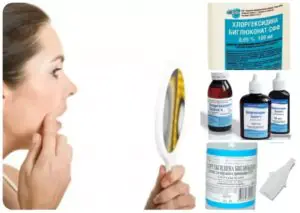
Description of Chlorhexidine
To eliminate acne, the component chlorhexidine is needed. Preparations containing the active substance are known under the trade names Miramistin and Chlorhexidine.
The drug has the appearance of a clear, colorless liquid. There is no noticeable odor. The effect is due to the basic properties. The drug has a pronounced bactericidal and antiseptic effect. To suppress gram-negative and gram-positive bacteria, a solution at a concentration of 0.01% is used, viruses - 0.05%. A weak antifungal effect was also noted.
Release form of Chlorhexidine
The drug can be used in various dosage forms, depending on the purpose of use. The following forms of Chlorhexidine exist:
- gel (containing lidocaine);
- solution (0.01-20%);
- cream;
- bactericidal patch;
- spray;
- candles.
It is advisable to use chlorhexidine in the form of a solution for acne. You should also pay attention to its concentration. A 0.01% solution is suitable for treating acne.
Does Chlorhexidine help with acne?
The product is effective for acne and blackheads due to its basic properties. After a few weeks of regular use, skin rashes and redness disappear. Unlike other drugs, Chlorhexidine also has a detrimental effect on viruses, which often infect the skin against the background of an inflammatory process.
The product is not only an antiseptic, but also a healing agent. It helps eliminate acne at any age. In some cases, complex treatment is necessary to achieve lasting results.
How does Chlorhexidine work against acne?
Elimination of pimples and acne occurs thanks to the disinfectant and antiseptic effect. The effect depends on the concentration of the solution. The death of pathogenic flora is noted. The use of the product allows you to stop the growth of bacteria.
Indications for use of Chlorhexidine
The solution is used not only for the treatment of acne. Experts name the following indications for the use of Chlorhexidine:
- therapy and prevention of skin diseases of bacterial or fungal etiology;
- acne;
- acne;
- treatment of burns or wounds;
- sterilization of medical instruments;
- hand disinfection.
Chlorhexidine digluconate is actively used in cosmetology for acne and as a means of reducing the severity of inflammation on the skin.
How to use Chlorhexidine for acne
Experts emphasize that if you have acne, it is advisable to contact a dermatologist or cosmetologist. The doctor will select the optimal treatment regimen.
It is not recommended to squeeze purulent pimples, so as not to aggravate the inflammation and spread of infection. If you need to squeeze out a pimple, you need to remember about the mandatory treatment with Chlorhexidine:
- the solution is applied to the hands and skin in the area of inflamed areas;
- the sterile needle is wiped with medical alcohol;
- use the tip of a treated needle to make a puncture in the abscess;
- the contents of the pimple are removed with a tampon, which is pre-moistened in the solution;
- Using a clean cotton pad soaked in Chlorhexidine, re-treat the inflamed lesion and adjacent areas.
The algorithm of actions allows you to get rid of redness and prevent infection of damaged areas.
The drug is often used in the form of applications or compresses. A cotton pad is moistened in the solution and applied to the abscess for several minutes. The procedure helps relieve swelling and redness. Applications can be carried out 2 times a day for several days.
This processing method is recommended due to its antiseptic and antimicrobial effect. The skin is wiped with a cotton swab soaked in Chlorhexidine twice a day. After 10 minutes, apply an anti-acne ointment, for example, Skinoren. The therapeutic course is 14 days.
When treating acne, masks based on chlorhexidine bigluconate are also used.
The mask normalizes the functioning of the sebaceous glands and helps eliminate oily sheen. In a bowl, mix black clay and solution in equal proportions. The mixture is applied to cleansed skin and washed off after 20 minutes. After the procedure, you need to apply a moisturizing cream to your face.
A special mask reduces the severity of inflammation and dries out the skin. It is recommended to perform the treatment procedure before bedtime. To prepare a therapeutic mask, you need to take 1.5 tablespoons of solution and powder without flavorings. The mixture should be thick. After the mask has dried, it must be removed by hand. The white coating is left until the morning. It is washed off with water, and then a cream with a moisturizing effect is applied to the face.
To enhance the effect, the solution is mixed with essential oils, such as chamomile. The mixture should be applied to the face and washed off with cool water after 20 minutes. This mask actively fights post-acne and evens out the complexion.
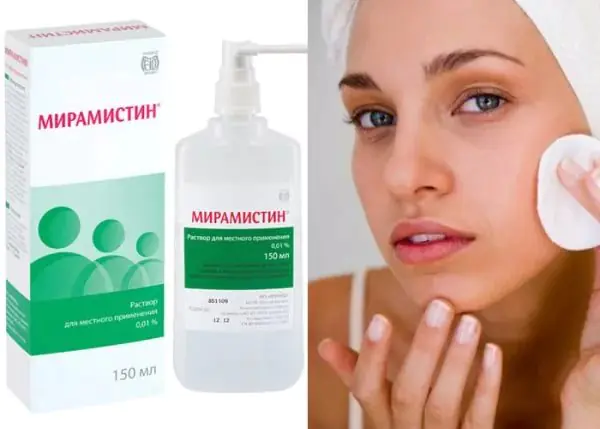
Advantages and disadvantages of Chlorhexidine
Treatment with Chlorhexidine has positive and negative aspects that are directly related to the effect of the drug. The advantages of the solution include:
- use for various therapeutic purposes due to activity against bacteria and viruses;
- effectiveness in the treatment of single acne;
- elimination of inflammation at an early stage;
- duration of exposure;
- penetration into deep layers.
During the use of the drug, a number of phenomena are observed that can be attributed to disadvantages. The following negative aspects associated with the use of the drug are identified:
- increased photosensitivity;
- a decrease in the protective properties of the skin, since the drug has a detrimental effect on both harmful and beneficial flora;
- decreased effectiveness when the solution comes into contact with pus or blood.
Side effects of Chlorhexidine
The drug is safe due to the lack of systemic effects. In exceptional cases, undesirable reactions may occur. Side effects include:
- local allergic reactions, such as irritation, itching or dryness;
- dermatitis;
- increased sensitivity to sun rays (photosensitization).
To exclude the occurrence of unwanted reactions, experts recommend conducting a sensitivity test. It involves applying a solution to the skin of the elbow. If there are no signs of allergy during the day, the product is recommended for use. Thus, acne on the face can be treated with Chlorhexidine.
Contraindications to the use of Chlorhexidine
Before using Chlorhexidine for acne, you need to study the instructions for its use. There are contraindications to external use of the drug:
- dermatitis;
- hypersensitivity reactions;
- breastfeeding period;
- pregnancy;
- age up to 12 years.
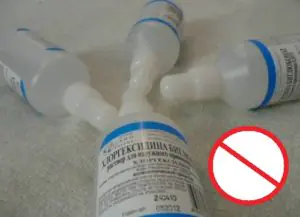
Compatibility of Chlorhexidine with other drugs
Before using the drug, you need to consider the following features:
- Hard water reduces the bactericidal properties of the drug.
- Heating the solution enhances the bactericidal effect.
- Before applying the product, you need to wash your face without using cleansers.
- Open areas are treated with caution in the summer due to the risk of photosensitivity.
Sometimes the solution is combined with antibacterial drugs to enhance its effect. These antibiotics include:
Medical alcohol enhances the effect of the product.
The drug is not prescribed simultaneously with drugs that contain:
Comparison of Chlorhexidine with analogues
Chlorhexidine bigluconate has analogue drugs.
The drugs differ in cost. Miramistin can be purchased at a pharmacy at a higher price.
Medicines have differences in chemical formula:
- benzyldimethyl ammonium monohydrate (Miramistin);
- chlorhexidine bigluconate (Chlorhexidine).
Miramistin is effective against complex viral infections and HIV. The drug has a milder effect and can be used for a long time. Side effects occur less frequently during treatment.
Both drugs take the form of a clear, odorless liquid used as an antiseptic. The difference lies in the nature of the effect and the chemical formula. When hydrogen peroxide comes into contact with the wound surface, microelements decompose. This solution has no long-term effect.
Dermatologists' opinion
Chlorhexidine for acne is an effective remedy. If you follow the rules of use, you can expect the manifestation of disinfectant and antiseptic properties. The solution stops the proliferation of bacteria and viruses. It is advisable to apply it pointwise to prevent the occurrence of unwanted reactions.
Conclusion
Chlorhexidine for acne is a budget drug for acne treatment. The product is used in various branches of medicine due to its beneficial qualities. A significant advantage is the safety of the drug and its long-term effects.
Reviews of the use of Chlorhexidine for acne
Reviews about the use of Chlorhexidine for acne on the face are quite contradictory.



